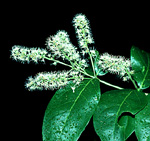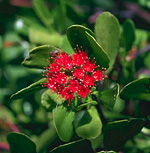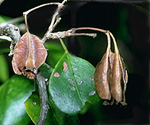 |
This is a small, pantropical family, mostly small trees and shrubs. They are often significant constituents of mangrove, savannah and monsoon forests across northern Australia.
Characteristic features of the family Combretaceae in Australia include: - trees or shrubs with alternate or opposite, entire, usually obovate leaves
- flowers small, usually in racemes or clustered into heads, with 5 free petals
- stamens 8-many, prominently exserted from corolla
- ovary inferior
- fruits dry and winged, or fleshy, with 1-2 seeds
Description
Evergreen, deciduous or semi-deciduous trees, shrubs, or woody or herbaceous vines climbing by twining stems. Adult leaves rarely replaced by phyllodes. Extra-floral nectaries ?on the leaves. Internal secretions of coloured sap. Plants with simple, non-glandular, unicellular hairs. Leaves alternate and spiral, or opposite, or in whorls of 3 or 4, petiolate, subsessile or sessile. Stipules absent. Lamina simple, symmetric, lanceolate, ovate, elliptic, oblanceolate, obovate or oblong; base cuneate, attenuate or cordate; margins entire, revolute or recurved, rarely ±flat; venation pinnate, with the midrib conspicuous, and the tertiary venation reticulate; surfaces punctate or not punctate; leathery. Domatia consisting of pits or pockets in the vein angles. Plants usually with all the flowers bisexual, or together with male flowers. Inflorescences axillary or terminal, consisting of racemes or solitary flowers. Bracts absent. Bracteoles present or absent. Flowers odourless, fragrant or malodorous; stalked. Floral disc present; nectaries present on the disc. Free hypanthium present. Perianth regular, of 2 dissimilar whorls or of 1 whorl only or all whorls ±similar. Calyx segments fused, with 4–5 (–8) lobes, valvate in bud; calyx funnel-shaped or tubular, herbaceous. Corolla segments free, with (0 or) 4–5 (–8) petals, alternating with the calyx lobes, imbricate or valvate in bud, white, cream or red; without contrasting markings, or streaked, spotted, etc, membranous; claws absent; lobes ±entire. Fertile stamens 8, 10 or 16, both alternating with and opposite to or not clearly correlated with the calyx lobes, at least partly fused to the corolla, free of ovary and style, distinct from each other, all ±equal. Anthers dorsifixed, versatile, opening sideways by longitudinal slits; 2-celled. Ovary inferior. Carpels 2–5, though fused and apparently 1; ovary with 1 locule. Style terminal, single and unbranched and the stigma truncate or capitate. Ovules 2–20, stalked; placentation apical. Fruit a dry or fleshy, indehiscent samara or a drupe; the perianth on the maturing fruit deciduous or rarely growing larger. Disseminule macro-surface featureless or winged; micro-surface ±smooth, red, green or black, glossy or dull. Seeds 1–2 per fruit. Cotyledons 2. Embryo sharply bent or coiled.
(Note: this description has been generated from the coded data compiled for the key. Any errors in the key data will be reflected in the descriptions.)
A treatment of the family Combretaceae has been published in:
Flora of Australia 18: 255-293.
Australian genera of Combretaceae (as recognised for the Flora of Australia)
* = all species introduced
Combretum
Danseia
Lumnitzera
Macropteranthes
*Quisqualis
Terminalia

|
  |

Combretum trifoliatum (flowers)
Photo: G.Sankowski © Zodiac Publications

Lumnitzera littorea (flowers)
Photo: D.Jones © D.Jones

Lumnitzera racemosa (flowers)
Photo: G.Leiper © G.Leiper

Macropteranthes fitzalanii (fruits)
Photo: H.Nicholson © H. & N. Nicholson

|
 |
|